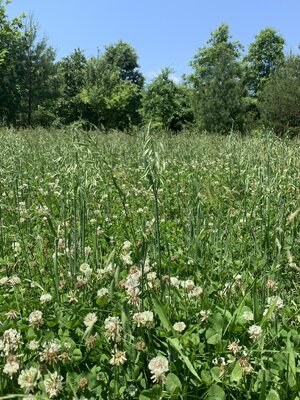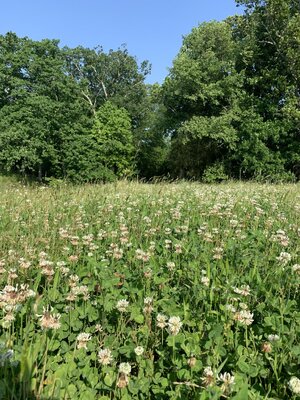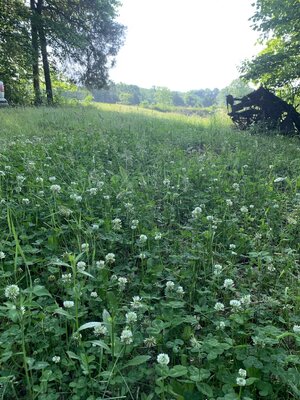-
The forum has been upgraded to support both light and dark themes. Click here for directions.
You are using an out of date browser. It may not display this or other websites correctly.
You should upgrade or use an alternative browser.
You should upgrade or use an alternative browser.
Take a walk with me through the prairie......
- Thread starter Native Hunter
- Start date
Native Hunter
Well-Known Member
A few days ago I was walking around the edge of the prairie and noticed some of this plant growing. I knew it was some type of Phlox, and tried to research it a little more. I have found that there are so many cultivated varieties that I can’t say for sure, but for right now I believe it to be what is called Smooth Phlox (Phlox glaberrima interior).
At the time I was there it was heavily browsed – almost to the point of killing the plant. Yesterday when I walked by it had been browsed even more and no flowers were visible. I have concluded that Phlox is a highly preferred browse of the whitetail deer. If anyone has more info, please chime it. I would also like some free seed….
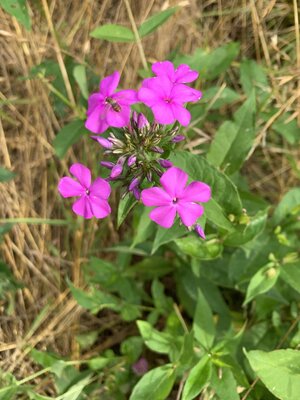
At the time I was there it was heavily browsed – almost to the point of killing the plant. Yesterday when I walked by it had been browsed even more and no flowers were visible. I have concluded that Phlox is a highly preferred browse of the whitetail deer. If anyone has more info, please chime it. I would also like some free seed….

Last edited:
Triple C
Well-Known Member
Love this thread. I'm slowly learning my plants across the landscape. Tried several apps over the years to identify what type plants I have growing. Settled on the Seek app. Take pic of plant and almost without fail, it identifies the plant with overview and links to more data. Something about walking thru my fields or woods and no being able to name plants that I had no idea of what they were several years ago.
This thread enables me to search for the same on my place. Thx for taking the time to update!
This thread enables me to search for the same on my place. Thx for taking the time to update!
Native Hunter
Well-Known Member
Love this thread. I'm slowly learning my plants across the landscape. Tried several apps over the years to identify what type plants I have growing. Settled on the Seek app. Take pic of plant and almost without fail, it identifies the plant with overview and links to more data. Something about walking thru my fields or woods and no being able to name plants that I had no idea of what they were several years ago.
This thread enables me to search for the same on my place. Thx for taking the time to update!
Thank you TC. I've had a busy summer and not able to keep this thread moving very much. The same goes for the oak thread that was started earlier this year. I plan to keep both of them going but probably won't get to post very often. I hope you and yours are having a great summer, and from the looks of those ribs, I know that everyone is eating very well.
Native Hunter
Well-Known Member
Most everyone is familiar with goldenrods, but this is one of the more unusual ones. It will usually be found at a prairie edge in semi shade and near tree roots. This is called Bluestem Goldenrod. It is a at least a moderately preferred browse. I found these near some beech roots at the edge when walking today.
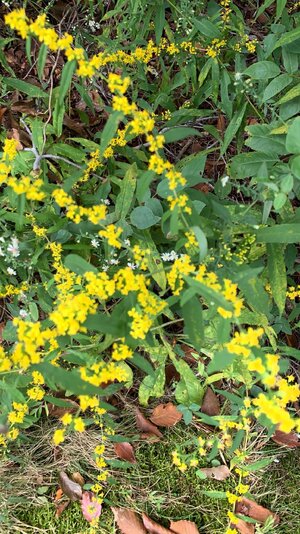

Last edited:
BoneCrusher20
Active Member
Do you find goldenrod to be somewhat invasive in your prairies? I'm not sure the variety we have, but we have about a 20 acre abandoned farm field that we let go "back to nature" and really what that has turned into is 90% goldenrod. Our honey bees love it in the fall, but that's about all it seems to be good for, as lays down in winter under snow and offers no summer flowers.Most everyone is familiar with goldenrods, but this is one of the more unusual ones. It will usually be found at a prairie edge in semi shade and near tree roots. This is called Bluestem Goldenrod. It is a at least a moderately preferred browse. I found these near some beech roots at the edge when walking today.

Native Hunter
Well-Known Member
Do you find goldenrod to be somewhat invasive in your prairies? I'm not sure the variety we have, but we have about a 20 acre abandoned farm field that we let go "back to nature" and really what that has turned into is 90% goldenrod. Our honey bees love it in the fall, but that's about all it seems to be good for, as lays down in winter under snow and offers no summer flowers.
Yes, the Canada Goldenrod and Tall Goldenrod are somewhat invasive. They can easily form colonies where they can choke out other species. If you can knock them back while the NWSGs are establishing, that seems to limit their ability later on to colonize.
My goldenrods seem to stand the winters pretty well but we don’t have nearly as much snow as you do in WI. It makes a lot of difference in winter standability.
Last edited:
BoneCrusher20
Active Member
Knock em back w/ mowing you think? or do you have to go herbicide route.Yes, the Canada Goldenrod and Tall Goldenrod are somewhat invasive. They can easily form colonies where they can choke out other species. If you can knock them back while the NWSGs are establishing, that seems to limit their ability later on to colonize.
My goldenrods seem to stand the winters pretty well but we don’t have nearly as much snow as you do in WI. It makes a lot of difference in winter standability.
Native Hunter
Well-Known Member
Knock em back w/ mowing you think? or do you have to go herbicide route.
When I started my prairie we did two gly kills before drilling NWSG and forb seed. That knocked back perennial grasses and goldenrods for the first year and gave the NWSGs a little breathing room early on. After a couple of years, however, the goldenrods will come back. I have had good luck setting them back with 24D. If that doesn’t work well you can use Crossbow and will really smack them but not bother NWSGs. But it will kill other broadleaf plants, so you need to spot spray. That’s what I do
Another herbicide that is good for both goldenrod and blackberry is Remedy Ultra.
I like the tall and Canada goldenrod scattered in the NWSGs as long as they don't colonize. The basal leaves are actually a preferred deer food after a frost.
Mowing is somewhat effective on goldenrod but not a great way to control them.
Last edited:
When I started my prairie we did two gly kills before drilling NWSG and forb seed. That knocked back perennial grasses and goldenrods for the first year and gave the NWSGs a little breathing room early on. After a couple of years, however, the goldenrods will come back. I have had good luck setting them back with 24D. If that doesn’t work well you can use Crossbow and will really smack them but not bother NWSGs. But it will kill other broadleaf plants, so you need to spot spray. That’s what I do
Another herbicide that is good for both goldenrod and blackberry is Remedy Ultra.
I like the tall and Canada goldenrod scattered in the NWSGs as long as they don't colonize. The basal leaves are actually a preferred deer food after a frost.
Mowing is somewhat effective on goldenrod but not a great way to control them.
When did you Spray Gly?
When did you plant?
Spring? Fall?
thanks
bill
Native Hunter
Well-Known Member
When did you Spray Gly?
When did you plant?
Spring? Fall?
thanks
bill
Bill, it was several years ago when I first converted my fescue pasture to NWSGs and forbs. I did two gly kills in the spring a few weeks apart and then drilled the seed after the second gly kill. Species planted were:
Indian Grass
Switchgrass
Big Bluestem
Little Bluestem
Side Oats Grama (has disappeared)
Virginia Wild Rye
Partridge Pea
Illinois Bundleflower (has disappeared)
Purple Coneflower
Blackeyed Susan
Several desirable forbs and undesirable forbs also came out from the seed bank afterwards. I have managed the prairie over the years by spot spraying undesirables with tanks in the back of a pickup truck and mowing.
Last edited:
Native Hunter
Well-Known Member
If managed correctly, a prairie can be a great place to hunt both turkey and deer. A prairie with a wall of 9 foot tall grass is perfect for deer, but a turkey won't enter it. I mow narrow shooting lanes for deer hunting in the fall, but in the spring, I widen them to facilitate turkey travel. This has been working well for us for several years. Today I built the latest turkey highway for this year.
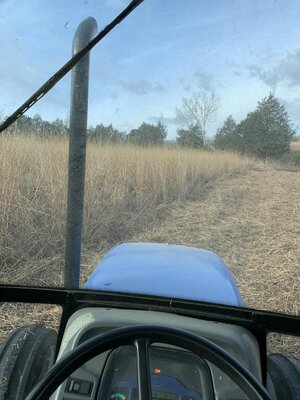

Last edited:
Kurt
Well-Known Member
Native Hunter, Great timing on picture. Barring bad weather, going to do that same kind of mowing on my place in Kansas in next week or so. Does that also stimulate faster spring growth? Any issues with the amount of hay left laying on the surface in those areas? I think it should for sure help my turkey hunting vs having all the tall stuff. And in a really dry year like this one is, it seems far safer than burning which I had wanted to do. My pasture is mostly 36-48" tall.
Native Hunter
Well-Known Member
Native Hunter, Great timing on picture. Barring bad weather, going to do that same kind of mowing on my place in Kansas in next week or so. Does that also stimulate faster spring growth? Any issues with the amount of hay left laying on the surface in those areas? I think it should for sure help my turkey hunting vs having all the tall stuff. And in a really dry year like this one is, it seems far safer than burning which I had wanted to do. My pasture is mostly 36-48" tall.
Kurt, I have always felt that it does stimulate faster spring growth. It breaks the dried grasses and forbs up into smaller pieces and lets the sunlight get through to the ground. I actually think that burning is better, but I have never had a problem with debris left on the ground from mowing, because it seems to decompose quickly enough. Turkeys need to be able to see in order to feel safe. They also need to be able to run quickly and take flight quickly without their wings hanging on anything. And of course, when you are trying to attract the ladies, you want them to be able to see you when you are strutting your stuff....
Native Hunter
Well-Known Member
I've posted so many plants in this thread that it's getting harder to find new ones. However, I came across a colony of this plant while doing spring prairie maintenance. It's call Beaked Corn Salad. It's not toxic and can be eaten by rabbits and deer. However, it's not a plant you see often, so it wouldn't be a major plant that would be browsed. It was pretty growing there at the edge of a ditch and caught my eye immediately as I passed by.
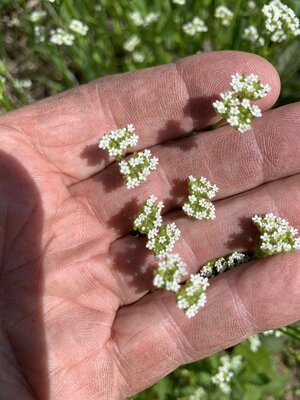
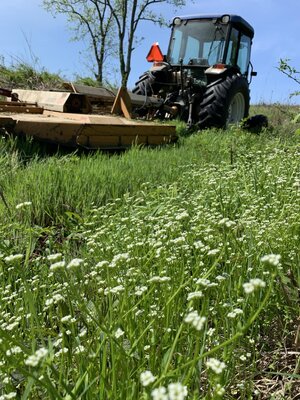


Last edited:
Native Hunter
Well-Known Member
We have a fair bit of phlox. I believe both pilosa and divaricata if memory serves me. I dont notice any browsing by deer, hereA few days ago I was walking around the edge of the prairie and noticed some of this plant growing. I knew it was some type of Phlox, and tried to research it a little more. I have found that there are so many cultivated varieties that I can’t say for sure, but for right now I believe it to be what is called Smooth Phlox (Phlox glaberrima interior).
At the time I was there it was heavily browsed – almost to the point of killing the plant. Yesterday when I walked by it had been browsed even more and no flowers were visible. I have concluded that Phlox is a highly preferred browse of the whitetail deer. If anyone has more info, please chime it. I would also like some free seed….

deer patch
Well-Known Member
Did the mowing work out as planned with the turkeys using it and how did your season go?If managed correctly, a prairie can be a great place to hunt both turkey and deer. A prairie with a wall of 9 foot tall grass is perfect for deer, but a turkey won't enter it. I mow narrow shooting lanes for deer hunting in the fall, but in the spring, I widen them to facilitate turkey travel. This has been working well for us for several years. Today I built the latest turkey highway for this year.

Native Hunter
Well-Known Member
Did the mowing work out as planned with the turkeys using it and how did your season go?
it did work like I planned, but I got tied up with a bunch of things and didn’t hunt much. Also, our Turkey population has gone down a lot over the last couple of years. There were only 3 toms on my property and the surrounding farms.
Similar threads
- Replies
- 74
- Views
- 3K

